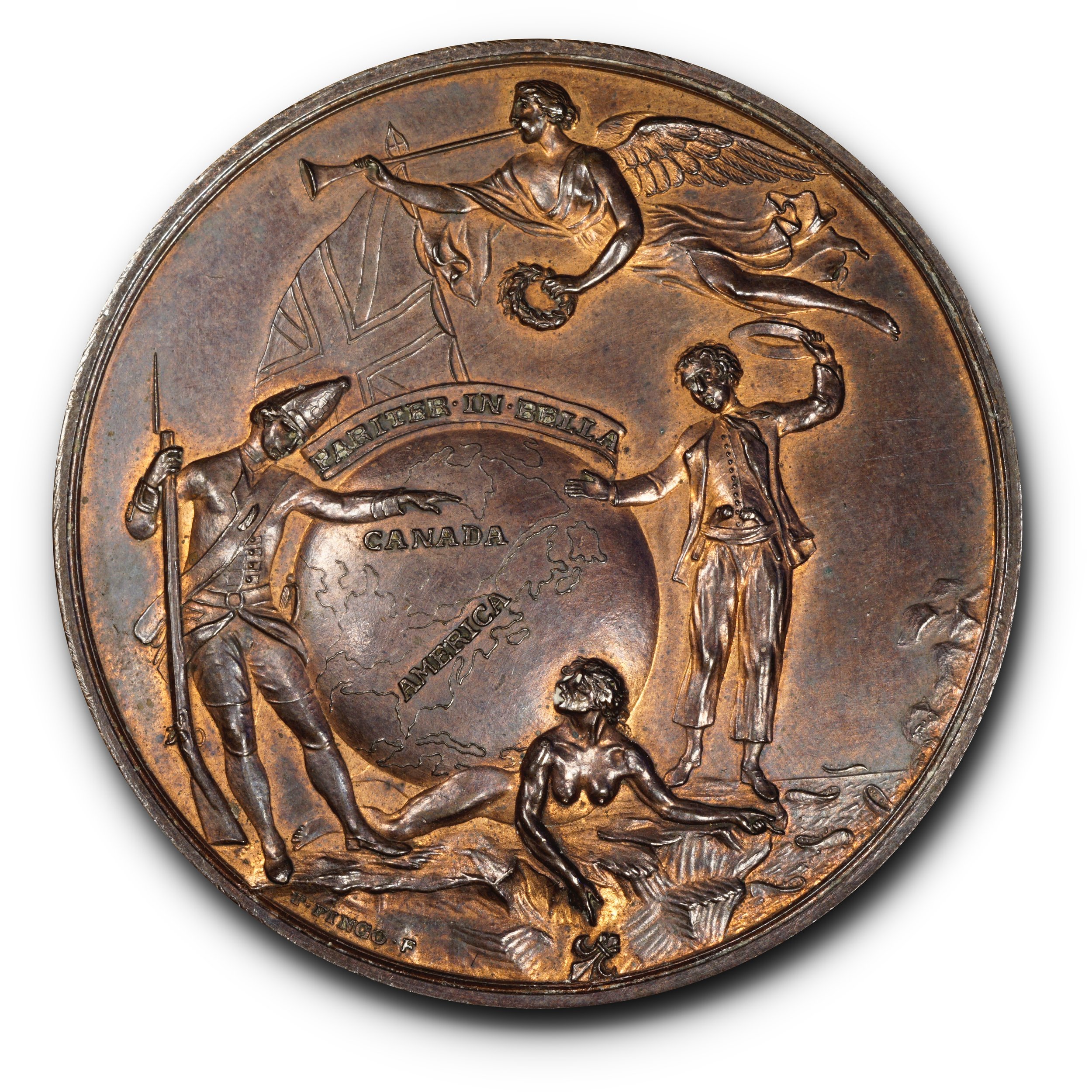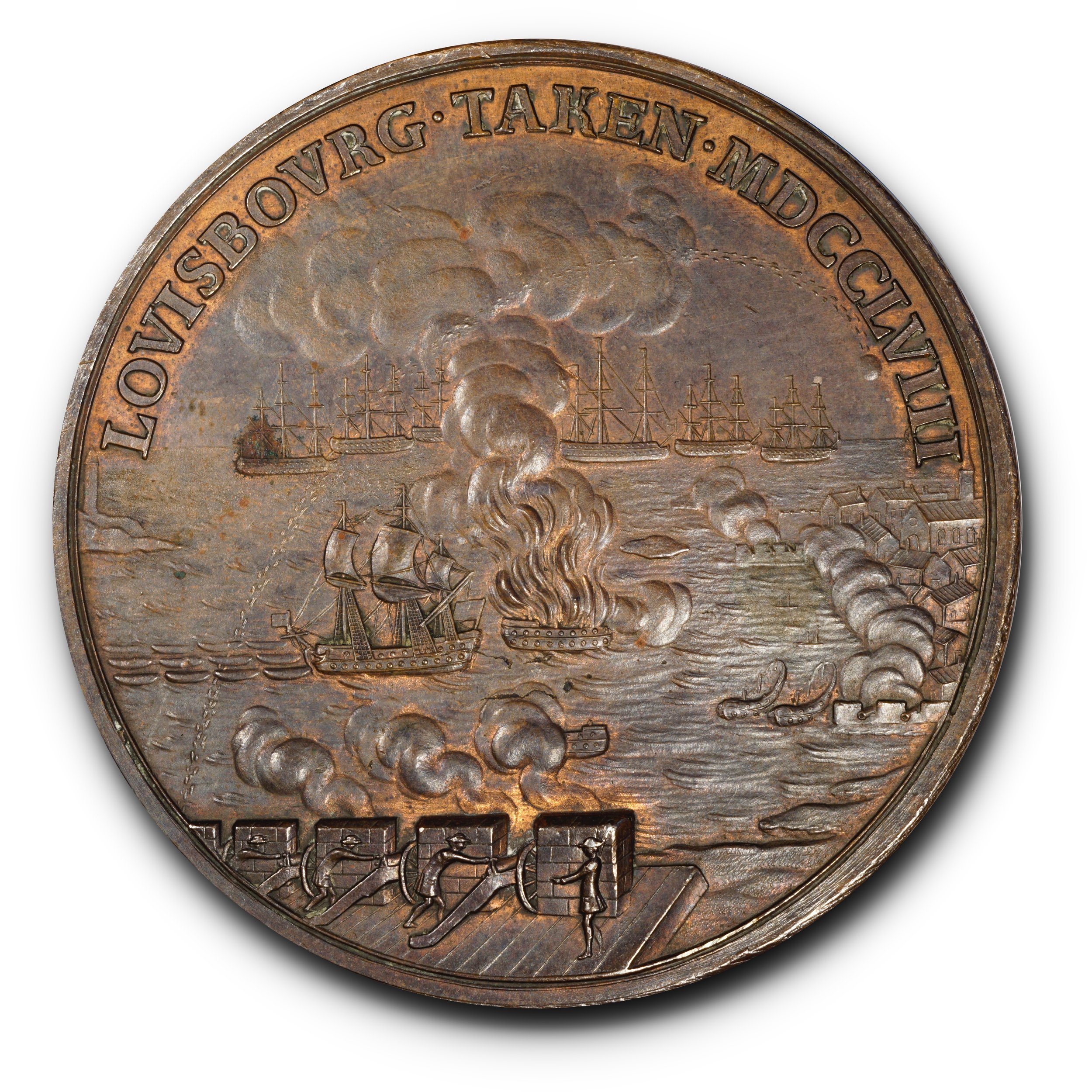1758 Louisbourg Taken Medal in Copper, LR-857. Unc.
McLachlan-369, Betts-410, Breton-49, Eimer-657. 43.6mm. 42.1g. Signed T. PINGO. One of the most significant entries in the Canadian historical medal series is also the first official British military campaign decoration, struck in copper (as here), silver, and gold. The obverse features a raised globe that prominently displays the words CANADA and AMERICA. A navy officer and solider appear right and left, with a female figure representative of the vanquished French army below. Victory and a British flag appear above with the motto PARITER IN BELLO (meaning "Equal or Together in War"). The reverse presents a meticulously rendered scene of the fortress of Louisbourg under siege, with cannons firing, ships in the harbour, and billowing smoke capturing the intensity of battle. Above the scene the inscription reads LOUISBOURG TAKENMDCCLVIII (1758).
As expected, these medals are more often found in copper than in silver, and more often in silver than in gold. However, any example is a numismatic rarity, particularly in this superb condition, and they only turn up in the most advanced collections. The images of this piece speak for themselves. Substantial glowing red colour remains, accenting unmarked medium brown surfaces.
Ex: Torex Winter Auction, Sale #6 (Jeffrey Hoare Auctions, 2/1988), lot 17; Tim Henderson.
McLachlan-369, Betts-410, Breton-49, Eimer-657. 43.6mm. 42.1g. Signed T. PINGO. One of the most significant entries in the Canadian historical medal series is also the first official British military campaign decoration, struck in copper (as here), silver, and gold. The obverse features a raised globe that prominently displays the words CANADA and AMERICA. A navy officer and solider appear right and left, with a female figure representative of the vanquished French army below. Victory and a British flag appear above with the motto PARITER IN BELLO (meaning "Equal or Together in War"). The reverse presents a meticulously rendered scene of the fortress of Louisbourg under siege, with cannons firing, ships in the harbour, and billowing smoke capturing the intensity of battle. Above the scene the inscription reads LOUISBOURG TAKENMDCCLVIII (1758).
As expected, these medals are more often found in copper than in silver, and more often in silver than in gold. However, any example is a numismatic rarity, particularly in this superb condition, and they only turn up in the most advanced collections. The images of this piece speak for themselves. Substantial glowing red colour remains, accenting unmarked medium brown surfaces.
Ex: Torex Winter Auction, Sale #6 (Jeffrey Hoare Auctions, 2/1988), lot 17; Tim Henderson.
McLachlan-369, Betts-410, Breton-49, Eimer-657. 43.6mm. 42.1g. Signed T. PINGO. One of the most significant entries in the Canadian historical medal series is also the first official British military campaign decoration, struck in copper (as here), silver, and gold. The obverse features a raised globe that prominently displays the words CANADA and AMERICA. A navy officer and solider appear right and left, with a female figure representative of the vanquished French army below. Victory and a British flag appear above with the motto PARITER IN BELLO (meaning "Equal or Together in War"). The reverse presents a meticulously rendered scene of the fortress of Louisbourg under siege, with cannons firing, ships in the harbour, and billowing smoke capturing the intensity of battle. Above the scene the inscription reads LOUISBOURG TAKENMDCCLVIII (1758).
As expected, these medals are more often found in copper than in silver, and more often in silver than in gold. However, any example is a numismatic rarity, particularly in this superb condition, and they only turn up in the most advanced collections. The images of this piece speak for themselves. Substantial glowing red colour remains, accenting unmarked medium brown surfaces.
Ex: Torex Winter Auction, Sale #6 (Jeffrey Hoare Auctions, 2/1988), lot 17; Tim Henderson.

